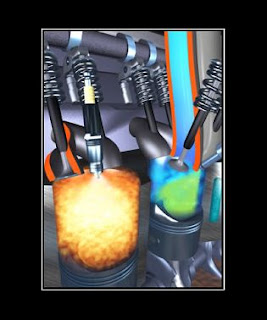GDI-TECH, Gasoline Direct Injection
With gas prices rising to ever higher catastrophic heights, automobile manufactures are continuing to search for fuel consumption answers. In recent years we have seen a growing trend in hydrogen, electric, diesel and hybrid fuel alternative vehicles; out of these alternatives only one seems to be gaining ground, hybrids. Hydrogen cars are a ways off because of storage and infrastructure problems. Electric cars... well, electric cars are not to be considered cars as far as I am concerned. Diesel engines are currently a rapidly growing alternative, especially in
So are true car enthusiasts doomed to awe, uninspiring performance? Can there possibly be a middle ground. I want power, I want good gas mileage, I want it all, don't you? Of course you do, and from the looks of it we might just get it. With newly, reinvented technology, direct injection engines are making their way back into the mainstream automakers repertoire. 
With the re-introduction of the GDI (Gasoline Direct Injection) engine car owners can expect to see an increase in power, better gas efficiency and better emissions then ever before. How? You might ask. The answer is much simpler than you might think. A GDI engine achieves all these things by simply having better control over its fuel delivery then a multi port injection system. In a multi port injection system fuel is delivered through the intake runners and mixes with air as it enters the cylinder during the intake stroke. A direct injection engine delivers fuel directly into the cylinder, after the air has entered, on the compression stroke. This allows spark plug to be surrounded by a small, precisely shaped volume of ignitable air-fuel mixture, directly around the spark plug, at the top of the cylinder. Other areas inside the combustion chamber merely contain air or re-circulated exhaust gas creating what is called a stratified charge. This type of charge allows the engine to burn mixtures much leaner then the conventional stoichiometric 14.7:1 air fuel ratio, up to 60 parts of air for every part of fuel (60:1), which in turn allows for a drastically cleaner burn and fewer emissions.
Although the answer is simple developing the technology isn't. There are many design challenges in a direct injection system. Most which involve operating within harsh environments.
Another design challenge was fuel delivery. Since the fuel on a GDI is injected right before ignition, there is very little time to generate a proper and accurate fuel spray. This was overcome with the development of faster microprocessors and high pressure fuel pumps which super-pressurize your fuel system.
Working out the kinks, swallowing the up front costs and delving in the idea of a new age GDI engine certainly should pay off when you look at all the benefits gained from such an efficient engine system. Imagine a car that everyone can be happy with. An engine that produces fewer emissions and is better for the environment and at the same time out performs your standard multi-port injection engine.


0 Response to "GDI-TECH, Gasoline Direct Injection"
Post a Comment